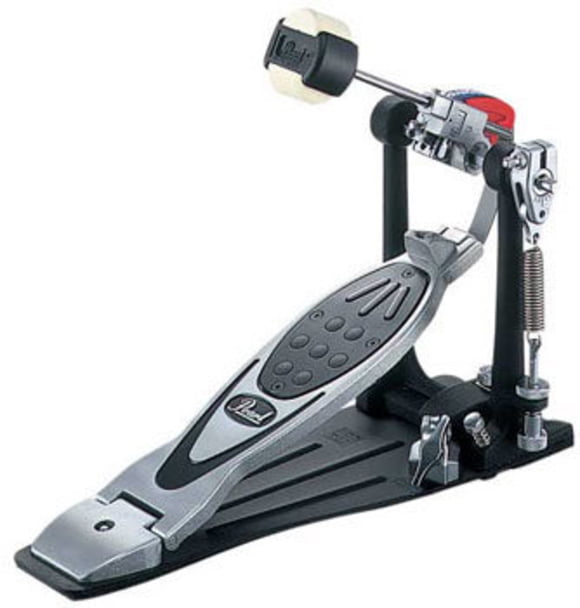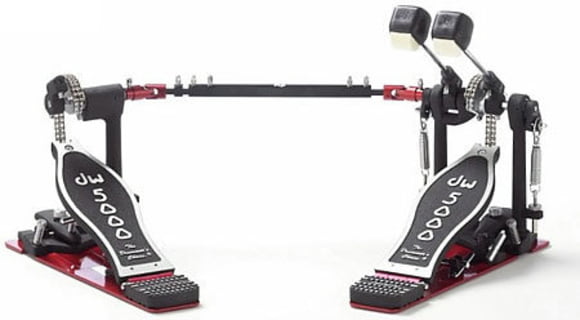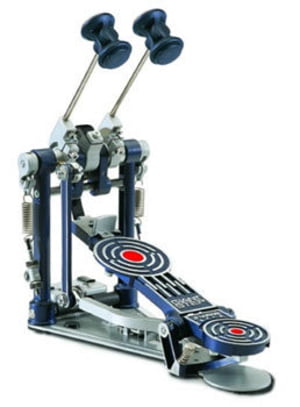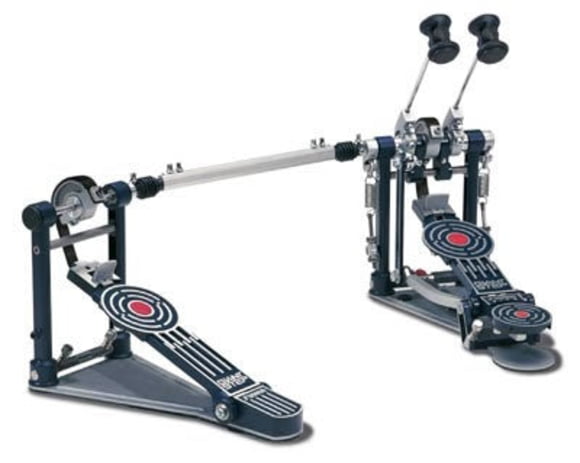2. Kick pedals
The kick pedal is a mechanism to play the bass drum with your foot. The movement of the foot is transferred by means of a more or less complex device into a controlled movement of the beater. The beater then hits the drum head - BOOOM. The spring then returns the beater into its starting position. The force developed by the foot when playing should not be underestimated and presents a real challenge to material and construction.
Every kick pedal should be assessed regarding ease of play, silence of mechanism and stability. There are simple kick pedals with little adjustment options and complicated ones with lots of them. The more options, the better. It is easier to adjust to the personal preferences.
Good pedals are characterized by the following criteria
- The whole device is of strong build. Insufficient material packs in mostly when you need it the least during a gig , when you suddenly step into nothing.
- The spring has a lot of space for adjustment, is easy to lock and can be reached without acrobatic abilities.
- the connection of the beaters on the shaft or cam is radially adjustable, i.e., swiveling this makes it easy to position between pedal and beater.
- The joints and shafts run in capsuled ball or needle bearings. This makes for silent running and ease of play. Furthermore the bearing is protected from dirt and dust.
- The clamp that holds the pedal on the hoop of the drum is easily accessible at least the setting screw should not be right underneath the pedal. The clamp itself is covered with rubber in order not to damage the hoop.
TIPP: Some Gaffa put on the hoop provides great grip for the clamp and protects the finish.
- The pedal has a reasonable profile and a little edge at the front. This way the foot does not slip on the pedal.
- The drive can be changed from chain to strap (or vice versa) There are different schools of thought to which one is better it is best if you can try both. At the end of the day it depends entirely on your personal likes and dislikes. Some more sophisticated models have different cam profiles to put on the drive. This actually influences the acceleration of the beater a bit like tuning the cam shaft on an engine.
- A big advantage are adjustable spurs. They prevent the drum from slipping forward when playing. The spurs however scratch the floor quite a bit. The use of a drum carpet is highly recommended.
Single pedals
One pedal ,one beater the most basic pedal. Single pedals can of course be quite sophisticated in their construction. Basic only applies to having just the one pedal.
The single kick pedal is the classic. All other designs could actually be classified as effect pedals. The single pedal finds its use mostly in Jazz, Country and the less demanding genres of rock. Complete drum sets often come equipped with a single pedal.
Double kick pedal
Two pedals, two beaters. Not so long ago , the double kick pedal was considered an extra. Nowadays it is almost the basic outfit for drummers in many musical styles. Double pedals allow for a substantially more complex and faster play than single machines. The double pedal also has the advantage that you dont need a second bass drum. This is not only cheaper but enables the drummer to place the pedals much more conveniently. Because only one bass drum is used it is also easier to synchronize the sound compared to two kick drums.
There is a left and a right version for double pedals. The extra pedal is therefore either left or right of the main pedal. Right handed drummers have the extra pedal left and lefties have it right (not to be confused with politics). The extra pedal however is always on the side of the hi hat.
Both pedal units are connected by a cardan drive. Both beaters are located on the right pedal (On right versions only of course). The right beater is played just as in a single pedal by the right foot. The second beater is operated by the extra pedal on the left via the cardan drive. This drive has two joints and is telescopic which makes positioning easy. The left pedal however can easily slip. It is imperative when setting up the drums to ensure stable positioning of the auxiliary pedal. Spurs alone are not sufficient. It is best to connect the unit with the hi hat using a multi clamp (accessories) or a base plate.
FX and triple pedal
The FX pedal is a single pedal with two beaters. The actual foot pedal is split into a heel and a ball section. One beater is operated by the heel, the other by the ball. Extremely complex and fast patterns can be performed with this device. If you are used to play a standard pedal though, you are in for a steep learning curve.
The triple pedal is a combination of FX - and a double pedal. The main side has the ball/heal split and the other a regular single pedal. It operates two beaters one is double engaged by the auxiliary pedal. The triple pedal is currently the most complex on the market and has huge musical potential. Just like the FX it needs getting used to. (Thomas Lang released an excellent DVD covering FX pedals ;-) )






